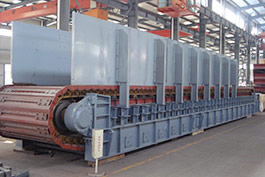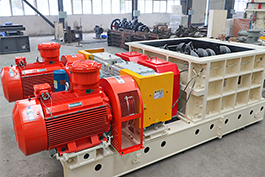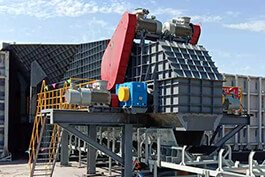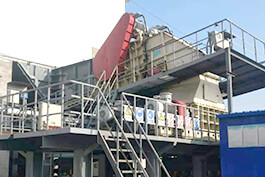Introduction
In mining operations, when dealing with large, sharp, heavy or highly abrasive ores, traditional feeding equipment often proves inadequate, inefficient, and accompanied by severe equipment wear and downtime risks. The apron feeder, with its design and structure, is capable of handling these materials. This article will provide an in-depth analysis for you on which materials the apron feeder can handle in the harsh environment of the mining industry.
Materials Processed by Apron Feeder in Mining
Metal ore materials
The typical metal ore materials processed by apron feeder include iron ore, copper ore, lead-zinc ore, manganese ore, gold ore, etc. For common iron ore, it has a high hardness and varying sizes. For copper ore, lead-zinc ore, manganese ore, and gold ore, they may have different physical properties, such as some having high density and some containing more impurities. The heavy trough plates and wear-resistant liners of apron feeder can effectively withstand impact and wear, ensuring that the materials do not cause excessive damage to the equipment during transportation.
Non-metal ore materials
Typical non-metal ore materials include limestone, granite, basalt, quartzite, gypsum, phosphate ore, etc. Limestone is hard in texture and causes significant wear to equipment during crushing and transportation. The sturdy structure of apron feeder ensures stable operation. Gypsum usually has certain stickiness and is prone to adhering to the equipment. Phosphate ore and coal gangue, among others, have varying block sizes and contain more moisture. Apron feeder, with its powerful processing capacity, can still efficiently complete the feeding task.
Energy and smelting materials
Coal (especially lump coal) and coke and other materials, although themselves have low hardness, often exist in a mixture of large blocks, medium blocks, small blocks and powder during mining, coking processing and transportation, and the materials tend to generate impact loads when falling. Apron feeder can handle mixed materials ranging from large blocks to powder and has certain impact resistance, making it suitable for use in the raw coal and coke transportation sections of coal mines and coke plants.
Other mining-related materials
Large chunks of waste rock and tailings generated during mining and beneficiation processes, as well as materials such as sintered ore and pelletized ore in metallurgical plants, usually have large block sizes and high temperatures, posing extremely high requirements for the thermal resistance and structural strength of equipment.
.jpg)
Analysis of Apron Feeders Material Adaptability Characteristics
Granularity requirement
The apron feeder of EXCT has a maximum pan width of 2800mm and can handle max feeding sizer 1800mm, functioning as a continuous conveying device. Its wide trough body and thick chain plate structure can accommodate and stably convey the raw large pieces of material directly generated after blasting in the mining site, without the need for secondary blasting or pre-crushing.
Hardness
The materials are generally of high hardness, with Mohs hardness ranging from 6 to 9. The trough plates of the apron feeder are made of high manganese steel, wear-resistant alloy steel, and even replaceable wear-resistant liners are installed, which greatly extends the service life. The heavy rollers and drive device also ensure that the equipment can operate stably when processing high-hardness materials, reducing equipment failures caused by excessively hard materials.
Humidity
The working conditions in mines are particularly challenging, especially when it rains outdoors or there is water gushing underground. Heavy-duty trough plates and specially designed conveying structures can effectively prevent the adhesion and blockage of damp materials during the conveying process. Even if the material moisture content is high, the apron feeder can maintain stable conveying efficiency and will not experience slipping or jamming due to excessive moisture.
Apron Feeder Performance Influencing Factors
Bulk density
Long-term operation can lead to increased wear of these components, as well as deformation, fracture and other faults. The drive system is also prone to overload. Therefore, thick trough plates, high-strength chains and powerful drive systems need to be selected to withstand the pressure and tension. For low-density materials, with the same volume, the load is smaller, and the structure and drive requirements of the equipment are relatively lower.
Feed particle size
The materials fall from a height of several meters, causing significant impact on the chain plate. The size of the feed particles also determines the magnitude of the impact force. If the feed particles are too large and exceed the range that the plate feeder can withstand, it will cause severe damage to the chain plate, chain and other components, shortening the service life of the equipment. Therefore, when dealing with large-sized materials, it is necessary to select a plate feeder with sufficient strength and impact resistance, and reasonably control the feed particle size to avoid equipment damage.
Motor power
The power of the motor directly determines the conveying capacity and operational stability of the plate feeder. When dealing with hard, large-grained or high-density materials, due to the increased resistance of the materials to the equipment, a greater driving force is required to ensure the normal operation of the equipment, so a motor with greater power needs to be equipped. On the contrary, when dealing with low-hardness, small-grained or low-density materials, the power of the motor can be appropriately reduced to lower energy consumption and costs.
Transportation speed
If the conveying speed is too fast, it may cause the materials to spill or be unevenly piled up during the conveying process, which will affect the accuracy and stability of the feeding, and also may accelerate the wear of the apron feeder components.
Apron Feeder Maintenance
Handling materials with high hardness and strong abrasiveness
Typical materials: iron ore, copper ore, granite, basalt, etc.
Main wear forms: cutting wear, impact fatigue wear.
Maintenance priorities and strategies
Chamfer plates and liner plates
Regular flipping: After a period of use, the new chamfer plates can be flipped for use, which will make the wear uniform and double the lifespan.
Stacking repair: For the worn surface of the chamfer plates, perform stacking repair (using wear-resistant welding rods), which is an economical and efficient method.
Check fastening: Daily check the fixing bolts of the liner plates to prevent the liner plates from shifting or falling off due to loosening.
Chains and sprockets
Regular tensioning: Wear will cause the chains to elongate, so the tensioning device of the apron feeder needs to be adjusted regularly to maintain the appropriate sag and avoid skipping teeth and chain detachment.
Lubrication: Although the environment is harsh, it is still necessary to lubricate the hinge parts of the chains daily to reduce abrasive wear. Adhesive lubricating grease can be used.
Supporting wheels and tracks
Cleaning: Clean the mineral powder accumulated on the tracks and wheels in time to prevent hard particles from becoming "grinding agents" and accelerating wear.
Check and replacement: The supporting wheels are vulnerable parts, and regular checks are needed to ensure that their rotation is flexible. If there is jamming or non-rotation, replace immediately.
Handling large, heavy and impactive materials
Typical materials: raw ore after blasting, large chunks of waste rock.
Main damage forms: impact load, structural fatigue, bolt loosening.
Maintenance priorities and strategies
Structural component inspection
Weld inspection: Regularly and carefully inspect the welds of key load-bearing parts such as the frame, trough support beams, etc. of the machine, for any cracks.
Trough plates
Install buffer devices: Add buffer beds or heavy rubber pads below the feeding points to directly absorb the impact energy of the materials and protect the trough plates and chains of the apron feeder.
Thickness upgrade: For particularly severe impact conditions, select thickened or special steel trough plates.
Handling moist and viscous materials
Typical materials: Wet clay, tailings, certain wet-process treated ores.
Main problems: Material adhesion, blockage, increased running resistance.
Maintenance priorities and strategies
Anti-adhesion and cleaning
Choose smooth trough plates: Avoid using grid-shaped trough plates and prefer smooth or with small edge guards trough plates to reduce attachment points.
Manual regular cleaning: After each shift, promptly clean the accumulated sludge on the apron feeder chain plate and the return track.
Chain and track
Pay attention to tension: Adhesive substances will increase running resistance, causing the chain load to increase, and it is necessary to check the tension more frequently.
Conclusion
The Apron Feeder, with its unique structure, durability, load-bearing capacity and material adaptability, can provide a stable and reliable conveying solution for hard and sharp metallic ores, large chunks of impact blasting materials, as well as damp and sticky minerals and waste materials.


.jpg)










